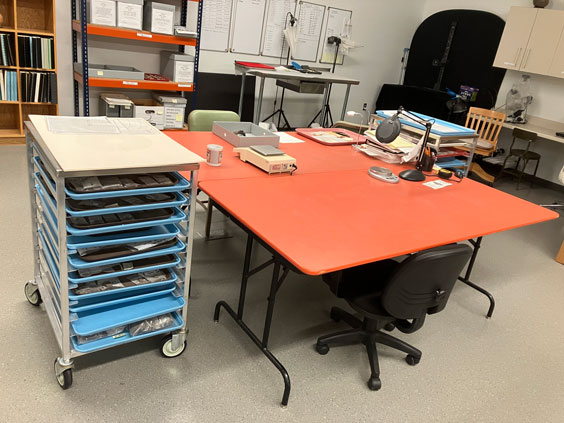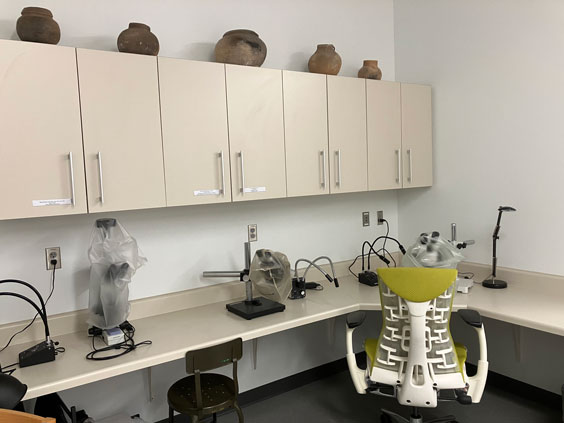In past blog posts, I gave a sneak peek at the initial processing lab, and previous staff have also written about the photography station in the main archaeology lab at the State Historical Society of North Dakota. But if you walk into the main archaeology lab there is still more that goes on—so here are a few additional aspects I would show you were you to take a tour today.

Welcome to the main archaeology lab! “Orange” you glad you came?
The area with the orange tables is where our volunteers and staff work on large projects. Currently we are repackaging artifacts from a site called Bagnell (32OL16) into better storage materials. Bagnell is the location of a village in Oliver County, which was excavated during the summers of 1970-73 by the late archaeologist Donald J. Lehmer. The most recent box of artifacts that our volunteers have been working on was full of seeds, corn cobs, charcoal, and wood.

A corn cob, squash stem, and beans from Bagnell village (32OL16). SHSND AHP 2019A.50, F154 H3 and Square H 1973
A long line of cabinets houses several reference or comparative collections. These collections are used by staff, volunteers, contract archaeologists, and researchers who are trying to better identify and learn more about the artifacts they are studying. Our three major reference collections include a faunal collection (animal bones), a lithic collection (rocks), and a shell collection.

These blue cabinets hold several of the archaeological reference collections.
The faunal reference collection is used to identify different kinds of animal bones found at archaeological sites such as villages, farmsteads, and forts. The kinds of animals present at a site tell us how people in a certain place and time lived and interacted with the world around them—what kinds of animals were raised, used, hunted, or living in the area.

These bones are from the faunal reference collection. All three are right scapulae (shoulder bones). The top scapula is from a bison, the middle one is a cast of a horse scapula, and the bottom example is from a white-tailed deer.
The lithic reference collection helps archaeologists confirm the type of rock from which an artifact—such as a scraper or a projectile point—is made. Some kinds of rocks are only found in specific places or regions. Knowing the type of stone used can often tell us something about where and how far people traveled to get certain tool materials or with whom they were trading.

The Eden projectile point on the left was found in McLean County (32ML1350) and is made from Rainy Buttes silicified wood. Examples of this material from the lithic reference collection are in the lower right corner. This rock is found in southwestern North Dakota. SHSND AHP 2020A.3.2
Likewise, the shell reference collection not only assists us in identifying the kind of shell that a pendant or gaming piece is made from but also where the shell was acquired by people or the extent of their connections and interactions with other groups of people. The peoples of North Dakota had extensive trade networks throughout history, and the presence of pendants and beads made from marine (ocean) shells found in archaeological contexts demonstrates this. As a result, we do have marine shells in our reference collection, which sometimes surprises people when they visit the lab. People living in North Dakota also used available local resources such as freshwater mussel shells and even fossil shells.

This photo shows a few examples from the shell reference collection. On the top row are different marine shells; in the middle row are fossilized shells that can be found in North Dakota; and the bottom row has two halves of a freshwater mussel that is also found in North Dakota.
Finally, the lab includes various study spaces for temporary staff, interns, and researchers to examine and catalog artifacts. It also contains equipment, such as microscopes, ready for use.

Room for research at one of the table spaces in the lab. Ceramics being studied are arranged on trays in a cart. The photography station can be seen in the upper right corner.

The lab’s microscope area. The pottery on top of the cabinets are modern replicas.
If you would like to schedule an in-person tour of the archaeology lab and/or archaeology collections, please contact us here.

